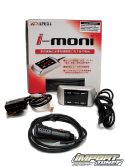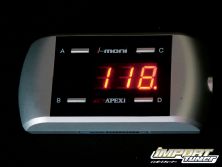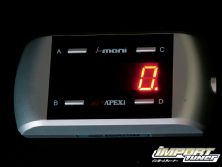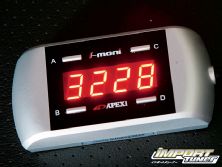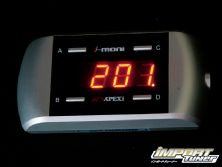The recently released i-moni is the first in a series of electronics that allows users to access vital data detected by the stock vehicle-sensors and relayed to the user in real time. The catch is you have to have a 1996 or newer vehicle with an ISO 14320 OBD-II port. In this case, you're OK if you own a Honda, Nissan, Toyota, Subaru, Mitsubishi, Suzuki or Daihatsu. Mazda folks are outta luck for now.Our initial assessment of the i-moni was that it is a hint understated: a gray case with four buttons labeled A, B, C and D. The red LCD display has an easily viewed font size and complimented the dash of our test vehicle (a 2005 Acura RSX Type-S).It's a straightforward plug-and-play system. Once you've located the OBD-II port under the dash and figured out a location for the screen you're well on your way. The included double-sided tape gives you the flexibility to mount the screen almost anywhere.The i-moni has several monitoring capabilities, including rpm, voltage, water temperature, intake temperature and vehicle speed. Some vehicles will not display all of the available functions. For those that do work, switching between the different features is seamless. The buttons are a little small and might be a challenge to push if you're driving or racing and need to toggle between features. But there is an audible beep that lets you know the keystroke was recognized.
Engine speed
Function A is engine speed, measured in rpm. This feature gives the user a digital tachometer. The ECU gets the same signal as the i-moni, in real time. It's quite accurate. We tested the i-moni against a timing gun and found the readings were within a few hundred revs at any given moment. This demonstrates the signal going to the ECU is in real time and that the i-moni is able to interpret that signal in real time to the user.
Intake air temperature
The intake air temperature sensor is generally mounted in the intake piping or on the intake manifold. The temperature of the intake charge can affect how much power a motor produces. Colder air is denser so you can squeeze in more oxygen and achieve greater combustion. Knowing whether your engine is breathing cold or hot air will make a difference in performance and driver expectation. If you're driving through Death Valley, Calif., in the summer, you're going to be reading much warmer intake temperatures, so you can expect a few less horsepower. We measured the temperature of the intake charge with an infrared thermometer against the reading displayed on the i-moni and found the factory sensor reads very accurately and relays the information to the i-moni screen in real time.
Water temperature
The water temperature feature is also a useful real-time monitor. We compared the i-moni readings with a laser thermometer. We found the water temperature sensor has a one- to two-second delay compared to the actual reading, but this could be due to the sensor's location. Otherwise, we were within a few degrees, which is pretty good for a factory sensor.
Vehicle speed
The vehicle speed mode reads without any delays, and is a reflection of the vehicle's speed sensor signal. It is very accurate compared to the speedo, and since this test vehicle was stock, the actual vehicle speed was within one mph compared to a radar gun.This unit also has a peak hold function for each category it monitors. The highest rpm, hottest water and air temperature, maximum speed and voltage are all stored for the duration of that particular session of driving. In addition, you can switch between Celsius and Fahrenheit, and mph and kph.
The i-moni does leave you wanting a little bit more, since it doesn't tell you which measurement unit you're reading (mph or kph/Celsius or Fahrenheit). Your only indication is a small red dot on the lower right corner, which at first glance is difficult to see. Some sort of unit marker would enhance the driver's experience. Also, the peak hold function is reset with each restart, so you will lose whatever peak hold data you've gathered unless you jot it down quickly. The buttons could be more intuitive by saying what mode they control instead of A, B, C or D. Lastly, the beeping sound that indicates a successful transition sounds a little distorted, as if the volume was turned up too high (and there is no volume control for the beeping sound).
For all the valuable information that can be had, this unit is a definite bargain. With an MSRP of $199, it will inform you of your vehicle's vital signs without cluttering your dash top with a bunch of gauges. Of course, this unit is only as precise as the vehicles' sensors and our test vehicle happened to be very accurate. Get one, and get informed.

